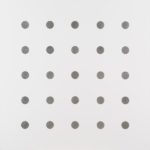Biography
Co-founder of the Ecart Group (1969) and closely affiliated with the Fluxus movement, visual artist John M Armleder has since the end of the 1960’s created a polymorphic body of work which encompasses performance, drawings, sculptures and paintings. Generally characterized by a sense of deep interconnectedness between life and art, and the appropriation of objects and quotes, his work is loaded with a set of influences and references which elude the modernist vernacular as well as any form of classification. Armleder gained international recognition with his Furniture Sculpture series from 1979, bringing together iconic examples of design and paintings to reflect on the trivialization of the artwork as an ornamental accessory. The artist is also recognized for his celebrated series of Pour and Puddle Paintings. “These works, born from his admiration for Larry Poons, and in accord with Armleder’s larger practice, do not hide the strategy of their fabrication nor the significance of their own process: conjuring a time liberated from formal constraints, moral obligations, and the conventions of taste and style.” (Extract from Stephanie Moisdon, ‘La Bruche du Haricot’, Almine Rech Gallery, Brussels, 2015).
John Armleder, has been using the dot motif since the late 1970s and they can be found in the artist’s paintings, drawings, sculpture and even his prints and multiple objects. Clearly paying homage to such avant-garde artists as Francis Picabia, Alexander Rodchenko, Larry Poons and even Thomas Downing, John Armleder, through his notion of appropriation, has raised the simple, optical concept and arrangement of dots from a pure mode of abstract pictorial composition to a systematic concept of representation and perhaps even structural analysis.
In the present work, painted in New York in 2005, the artist has arranged five rows and five columns of metallic silver dots on a stark white painted canvas. At first glance, the composition appears rather simple, formulaic and even mundane; twenty-five 2 1⁄2 inch dots placed in a grid within a four by four foot picture plane. However like in so many of John Armleder’s best works, it is the simplicity of the concept that raises the work of art, and with it, the viewers perception of it, to another level.
In further observing the work, it becomes evident that the artist has ever so slightly raised and lowered the plane of each dot, disrupting the grid and creating a perception of optics. What initially appears as a simple and static picture, gradually gives way to an extremely active surface. The viewers eyes begin to create patterns within the grid. The canvas starts to pulsate and there is a sensation of depth, a push-pull, within the flat, two-dimensional space. John Armleder has appropriated the formulaic and highly structured notion of OpArt while at the same time completely dismantling its perceived concept of order and repetition. By altering the height of the dots, even slightly, the artist has created a dynamic and disordered optical perception and sense of depth within a seemingly flat picture plane.

 H Painting
H Painting